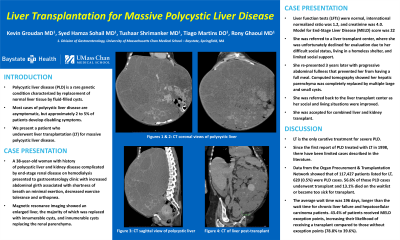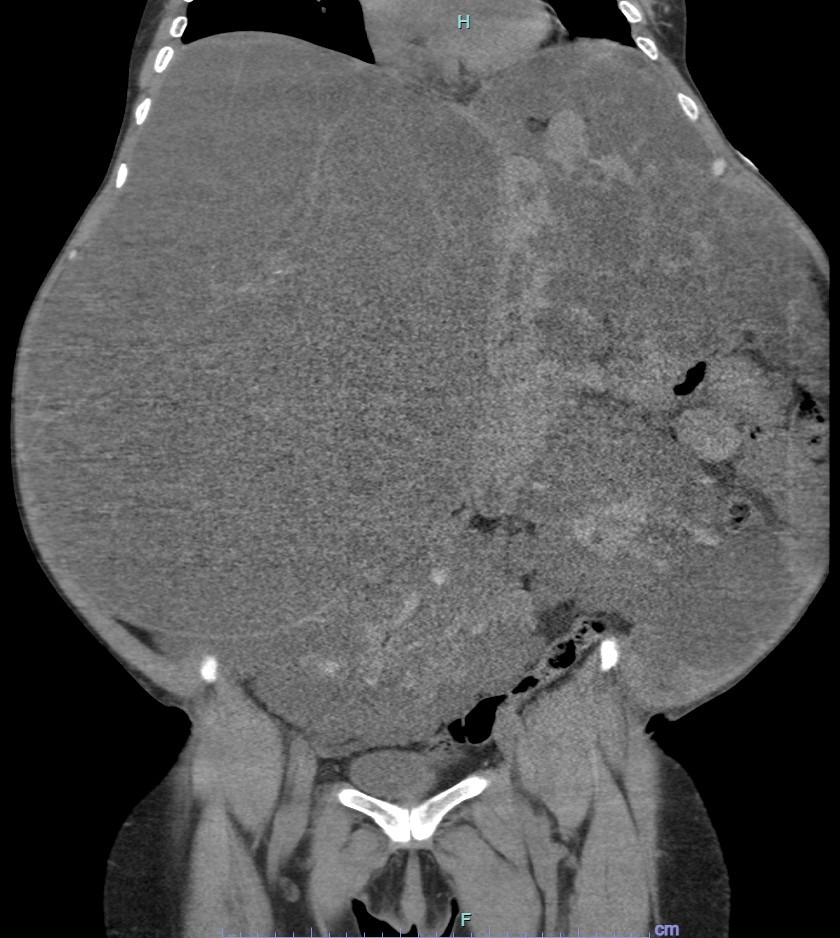Sunday Poster Session
Category: Liver
P1297 - Liver Transplantation for Massive Polycystic Liver Disease
Sunday, October 27, 2024
3:30 PM - 7:00 PM ET
Location: Exhibit Hall E

Has Audio
- KG
Kevin Groudan, MD
University of Massachusetts Chan Medical School - Baystate
Springfield, MA
Presenting Author(s)
Kevin Groudan, MD, Syed Hamza Sohail, MD, Tushaar Shrimanker, MD, Tiago Martins, DO, Rony Ghaoui, MD
University of Massachusetts Chan Medical School - Baystate Health, Springfield, MA
Introduction: Polycystic liver disease (PLD) is a rare genetic condition characterized by replacement of normal liver tissue by fluid-filled cysts. Most cases of PLD are asymptomatic, but approximately 2 to 5% of patients develop disabling symptoms that severely reduce their quality of life. We present a patient who underwent liver transplantation (LT) for massive PLD.
Case Description/Methods: A 38-year-old woman with history of polycystic liver and kidney disease complicated by end-stage renal disease on hemodialysis presented to gastroenterology clinic with increased abdominal girth from her liver cysts associated with shortness of breath on minimal exertion, decreased exercise tolerance and orthopnea. Magnetic resonance imaging showed an enlarged liver, the majority of which was replaced with innumerable cysts, and innumerable cysts replacing the renal parenchyma. Liver function tests (LFTs) were normal, international normalized ratio was 1.2, and creatinine was 4.0. Model for End-Stage Liver Disease (MELD) score was 22. She was referred to a liver transplant center, where she was unfortunately declined for evaluation due to her difficult social status, living in a homeless shelter, and limited social support.
She re-presented 3 years later with progressive abdominal fullness that prevented her from having a full meal. Computed tomography showed her hepatic parenchyma was completely replaced by multiple large and small cysts (Figure 1). She was referred back to the liver transplant center as her social and living situations were improved. She was initially planned for renal transplant with liver cyst defenestration because of her normal LFTs, but due to her complex anatomy, she was eventually accepted for combined liver and kidney transplant.
Discussion: LT is the only curative treatment for severe PLD. Since the first report of PLD treated with LT in 1998, there have been limited cases described in the literature. Data from the Organ Procurement & Transplantation Network showed that of 117,427 patients listed for LT, 620 (0.5%) were PLD cases. 56.6% of those PLD cases underwent transplant and 13.1% died on the waitlist or became too sick for transplant. The average wait time was 196 days, longer than the wait time for chronic liver failure and hepatocellular carcinoma patients. 43.4% of patients received MELD exception points, increasing their likelihood of receiving a transplant compared to those without exception points (78.8% to 39.6%).

Disclosures:
Kevin Groudan, MD, Syed Hamza Sohail, MD, Tushaar Shrimanker, MD, Tiago Martins, DO, Rony Ghaoui, MD. P1297 - Liver Transplantation for Massive Polycystic Liver Disease, ACG 2024 Annual Scientific Meeting Abstracts. Philadelphia, PA: American College of Gastroenterology.
University of Massachusetts Chan Medical School - Baystate Health, Springfield, MA
Introduction: Polycystic liver disease (PLD) is a rare genetic condition characterized by replacement of normal liver tissue by fluid-filled cysts. Most cases of PLD are asymptomatic, but approximately 2 to 5% of patients develop disabling symptoms that severely reduce their quality of life. We present a patient who underwent liver transplantation (LT) for massive PLD.
Case Description/Methods: A 38-year-old woman with history of polycystic liver and kidney disease complicated by end-stage renal disease on hemodialysis presented to gastroenterology clinic with increased abdominal girth from her liver cysts associated with shortness of breath on minimal exertion, decreased exercise tolerance and orthopnea. Magnetic resonance imaging showed an enlarged liver, the majority of which was replaced with innumerable cysts, and innumerable cysts replacing the renal parenchyma. Liver function tests (LFTs) were normal, international normalized ratio was 1.2, and creatinine was 4.0. Model for End-Stage Liver Disease (MELD) score was 22. She was referred to a liver transplant center, where she was unfortunately declined for evaluation due to her difficult social status, living in a homeless shelter, and limited social support.
She re-presented 3 years later with progressive abdominal fullness that prevented her from having a full meal. Computed tomography showed her hepatic parenchyma was completely replaced by multiple large and small cysts (Figure 1). She was referred back to the liver transplant center as her social and living situations were improved. She was initially planned for renal transplant with liver cyst defenestration because of her normal LFTs, but due to her complex anatomy, she was eventually accepted for combined liver and kidney transplant.
Discussion: LT is the only curative treatment for severe PLD. Since the first report of PLD treated with LT in 1998, there have been limited cases described in the literature. Data from the Organ Procurement & Transplantation Network showed that of 117,427 patients listed for LT, 620 (0.5%) were PLD cases. 56.6% of those PLD cases underwent transplant and 13.1% died on the waitlist or became too sick for transplant. The average wait time was 196 days, longer than the wait time for chronic liver failure and hepatocellular carcinoma patients. 43.4% of patients received MELD exception points, increasing their likelihood of receiving a transplant compared to those without exception points (78.8% to 39.6%).

Figure: Figure 1: Hepatic parenchyma is completely replaced by multiple large and small cysts
Disclosures:
Kevin Groudan indicated no relevant financial relationships.
Syed Hamza Sohail indicated no relevant financial relationships.
Tushaar Shrimanker indicated no relevant financial relationships.
Tiago Martins indicated no relevant financial relationships.
Rony Ghaoui indicated no relevant financial relationships.
Kevin Groudan, MD, Syed Hamza Sohail, MD, Tushaar Shrimanker, MD, Tiago Martins, DO, Rony Ghaoui, MD. P1297 - Liver Transplantation for Massive Polycystic Liver Disease, ACG 2024 Annual Scientific Meeting Abstracts. Philadelphia, PA: American College of Gastroenterology.
